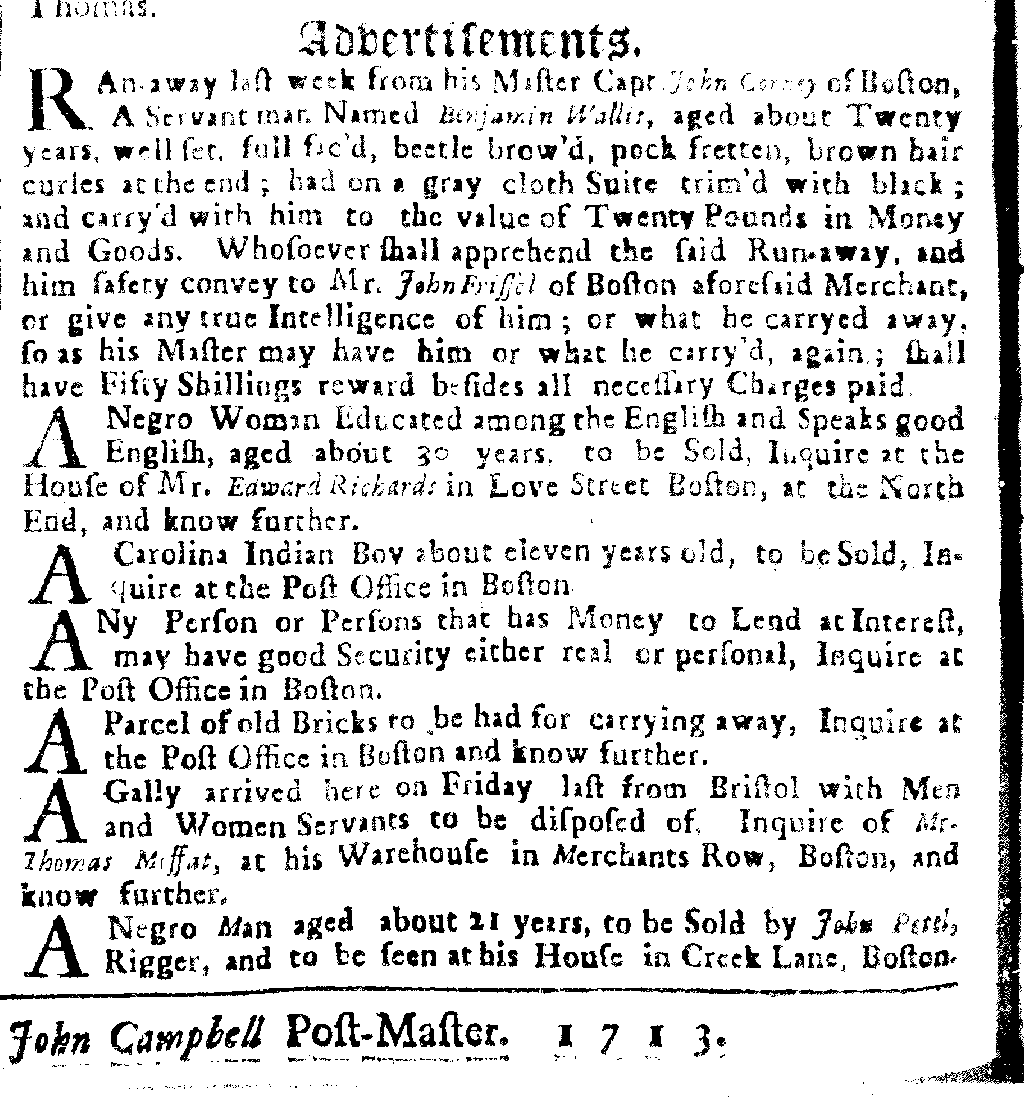The Tuscarora War, and the Yamasee War that followed it in South Carolina, transformed the lives of North Carolina's native peoples. Already weakened by disease and rapidly losing their land to colonists, the remnants of many independent tribes joined together on small reservations or left the colony entirely. By 1720, only the Cherokee remained intact. North Carolina east of the mountains was essentially cleared for white settlement.
Disease strikes the Piedmont
Although the first European explorers had introduced Old World diseases into the Americas centuries before, the first major smallpox epidemic did not strike most of what is now the southeastern United States until the 1690s. The outbreak began in 1696 in Virginia and quickly spread throughout the colonial population, especially among Africans and children who had never been exposed to smallpox. The disease then traveled into North Carolina, and by 1697 was sweeping through South Carolina.1
Everyone in the Carolinas was susceptible to smallpox, but American Indians suffered the worst effects. When John Lawson explored the Carolina backcountry in 1701, he found that smallpox had nearly wiped out several tribes of the Carolina Piedmont, including the Sewees and Congarees.
The Small-Pox has been fatal to them; they do not often escape, when they are seiz'd with that Distemper, which is a contrary Fever to what they ever knew. Most certain, it had never visited America, before the Discovery thereof by the Christians. Their running into the Water, in the Extremity of this Disease, strikes it in, and kills all that use it. Now they are become a little wiser; but formerly it destroy'd whole Towns, without leaving one Indian alive in the Village. The Plague was never known amongst them, that I could learn by what Enquiry I have made: These Savages use Scarrification almost in all Distempers. Their chief Instruments for that Operation is the Teeth of Rattle-Snakes, which they poison withal. They take them out of the Snake's Head, and suck out the Poison with their Months, (and so keep them for use) and spit out the Venom, which is green, and are never damag'd thereby. The Small-Pox and Rum have made such a Destruction amongst them, that, on good grounds, I do believe, there is not the sixth Savage living within two hundred Miles of all our Settlements, as there were fifty Years ago.
It's possible that the Cherokee, living further west in the mountains, were spared during the epidemic of 1696-1700. But the other native peoples of the Carolinas were devastated. More epidemics of smallpox and other diseases would follow in the 1700s, and native populations would never recover.
A desperate war
The name "Tuscarora War" suggests that the war was fought between the Tuscarora and European colonists. In fact, many tribes fought on both sides, and almost all of the American Indians of the Carolinas were affected. Algonquian tribes of the Coastal Plain such as the Coree, Matchapunga, Pamlico, Bear River and Neusioc Indians joined the Tuscarora. Various Siouan tribes, including the Yamasee, Catawba, Sara, Sugaree, Waccamaw, and Cape Fear allied themselves with the settlers, as did the Cherokee. Some groups of Tuscarora tried to stay neutral, but found it hard not to be swept up in the violence.
No one knows just what sparked the Tuscarora War. The migration of Swiss and German settlers to New Bern may have been the last straw. When Lawson and Graffenried explored the Neuse River in 1711, the Tuscarora told Graffenried that they had already decided on war. The northern Iroquois, to whom the Tuscarora were related, may have prodded the Tuscarora into war. One historian has even suggested that what sparked the war was the eighteenth-century equivalent of a bar fight between a white settler and a Tuscarora!2
The Tuscarora certainly had reasons to be angry with the colonists. The English systematically enslaved Carolina's native peoples. European farmers occupied Tuscarora hunting grounds, and the Tuscarora found themselves squeezed into less and less land. Virginia's governor, Alexander Spotswood, warned North Carolina governor Edward Hyde that war would probably be the result. In fact, he found Indian retaliation "excusable," since "your people have been the first aggressors, by seating without Right on the Lands of which the Indians had first possession."3
Whatever their immediate reason for going to war, the Tuscarora seem to have seen the handwriting on the wall. The Europeans would continue to arrive, would keep taking their lands and enslaving their people. With few options left, the Tuscarora decided to risk everything to try to drive the colonists out of their land.
Loss of people, loss of land
Thousands of Indians were killed or captured in battle. Many colonists were already inclined to see Indians as barbaric; now, infuriated by the massacres that started the war, they eagerly retaliated. John Lawson was dead, and his hopes that Europeans and Indians could live together peacefully in North Carolina died with him. The colonists saw the war as an opportunity to get rid of the Tuscarora once and for all. In 1713, an army of colonial troops and allied Indians laid siege to Fort Neoheroka, a Tuscarora stronghold. When the colonial forces burned the fort, the fire killed as many as 500 men, women, and children. More than 400 more were captured when they tried to flee.4
By order of the Executive Council of North Carolina, Indians captured in battle by colonial forces were sold into slavery:
This board having taken into their consideration the necesity of disposing by sale of the Indian Captives now in custody, called the Bay River Indians, who not only have been privy and consenting to the late bloody massacre, but have actually assaulted by force and arms, several of the inhabitants of this government: as well to prevent unnecessary charge as to refund several considerable sums of money, which have been disbursed on emergent occasions by the Hon. Edwd. Hyde President and the Hon. Col. Pollock Esq. for the public service: Ordered that the said Bay River Indians be brought to Capt. John Heckelfield's, the third day of the next Genl. Court, and there be exposed to public sale by the Provost Marshal or his deputy, by way of Vendue, to the highest bidder, the purchaser giving security in the sum of one thousand pounds to export the said Indians out of the government, in one month after the said purchase; and likewise the purchaser to give bone with good security for the payment of the purchase money in November next to the Hon. Edward Hyde Esq. President and the Hon. Col. Thos. Pollock Esqr.5
The colonists had broken the power of the Tuscarora, but an even bloodier war would soon follow.
The Yamasee War
The Tuscarora War showed the Indians of the Carolinas the value of cooperation against the English. Tribes that had traditionally been enemies joined colonial forces to fight the Tuscarora, hoping that the colonists would respect their land and their interests. But in South Carolina, colonists continued to encroach on Indian land. Various tribes of the Piedmont stayed in communication and began to discuss war against the colonists.
In 1715, the Yamasee attacked several South Carolina plantations. Other Indians, including the Creek, killed British traders in their territories. In the war that followed, an army of South Carolinians fought the Yamasee, Catawba, Ochese Creek, and other Indians.
The Cherokee allied themselves with South Carolina in 1716, effectively ending the war. But the war killed as many as 7 percent of the colony's white citizens, and many Piedmont tribes suffered great losses.
Consolidation
In 1701, despite the recent epidemics, John Lawson had found more than a dozen tribes living throughout the Piedmont. Just twenty years later, the North Carolina Piedmont would be empty, and only tiny remnants of the peoples of the coastal plain would remain.
Devastated by disease, many of North Carolina's Indians were already consolidating before the Tuscarora War. In about 1709, the Saponi, Occaneechee, and other groups moved to northeastern North Carolina from the Piedmont to be closer to colonial trade. In 1714, after the worst fighting of the Tuscarora War, they formed the Saponi Nation. The Nansemond of southeastern Virginia soon joined them. Governor Alexander Spotswood of Virginia, hoping to convert the Saponi to Christianity and to protect colonists from attacks by northern Iroquois, built Fort Christianna in southeastern Virginia to house the Saponi.
After the Tuscarora War, most of the remaining Tuscarora moved to New York, where they became the sixth nation of the Iroquois Confederacy, a powerful alliance of tribes living in New York, New England, Pennsylvania, and southern Canada. Some of the neutral Tuscarora remained in North Carolina, where they lived on a reservation in Bertie County. Both the modern Haliwa-Saponi and Lumbee peoples claim ancestry from the Tuscarora.
To the south, in the aftermath of the Yamasee War, the remnants of the Congaree, Sugaree, Wateree, Waxhaw, and other Indians of South Carolina's Piedmont joined the Catawba -- some voluntarily, some as slaves. The Shakori, who had once lived around Hillsborough, also joined them. They lived on the North Carolina-South Carolina border south of present-day Charlotte, and were the origin of the modern Catawba nation. The Sara and Eno peoples, who had recently lived in the northern Piedmont of North Carolina, joined with the Cheraw in northeastern South Carolina.
The Cherokee remained free and intact as a people -- partly because they had allied themselves with the governments of the two Carolinas, and partly because disease had not yet swept through the southern Blue Ridge where they lived.
1. Paul Kelton, "The Great Southeastern Smallpox Epidemic, 1696-1700: The Region's First Major Epidemic?", in Robbie Ethridge and Charles Hudson, eds., The Transformation of the Southeastern Indians, 1540-1760 (Jackson, Miss.: University Press of Mississippi, 1998), pp. 21-38. Kelton argues that if smallpox struck the Southeast earlier, in the sixteenth century when the first Spanish explorers came through the region, native populations had time to recover before the disease arrived again in 1696.
2. Gallay, Alan, The Indian Slave Trade: The Rise of the English Empire in the American South, 1670-1717 (New Haven, Conn.: Yale University Press, 2002), 265.
3. Ibid., 262.
4. The estimate of casualties is from "Catechna and The Tuscarora War," provided by the State Library of North Carolina.
5. Robert J. Cain, ed., The Colonial Records of North Carolina [second series], VII, Records of the Executive Council, 1664-1734 (Raleigh: Department of Cultural Resources, Division of Archives and History, 1984), p. 8.

